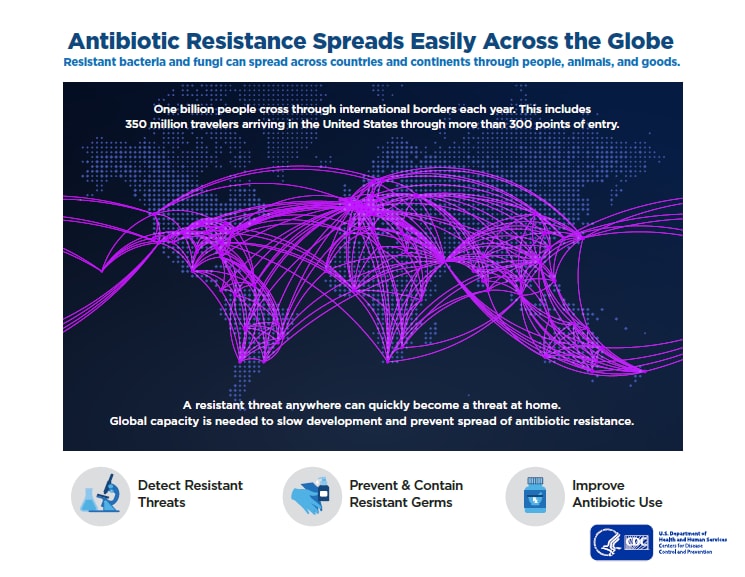Combat Antimicrobial Resistance Globally
On This Page
Terms
On CDC’s website, antibiotic resistance is also referred to as antimicrobial resistance or drug resistance.
The One Health concept recognizes that the health of people is connected to the health of animals and the environment.
A Global Problem and Priority
Antimicrobial resistance has been found in all regions of the world. Modern travel of people, animals, and goods means antimicrobial resistance can easily spread across borders and continents.
Fighting this threat is a public health priority. It requires a collaborative global approach across sectors to detect, prevent, and respond to these threats when they occur.
Global Strategies to Fight Resistance
Every country can take steps to slow antimicrobial resistance. Commit to setting goals across multiple sectors, including:
- Healthcare
- Food
- Communities (local and global)
- Environment (soil and water)
Create and implement a comprehensive plan with a One Health approach to achieve those goals, and track progress.
Every country plan can consider the following actions to prevent resistant infections and their spread:
- Implement infection prevention and control practices
- Improve antibiotic use, including ensuring access
- Implement data and tracking systems to track resistance, guide prevention strategies, and report results at the local and global level
- Improve lab capacity to identify resistant bacteria
In addition to these important actions, it is also critical to join the global effort to develop new drugs, diagnostics, vaccines, and therapeutics to treat infections.
Find out how the U.S. government and CDC are leading efforts in the U.S. to combat resistance:
CDC Collaborates to Support Global Action
CDC works with world leaders and experts to implement the U.S. National Action Plan for Combating Antimicrobial Resistant Bacteria. Through CDC’s Antibiotic Resistance Solutions Initiative, the agency supports activities in high burden countries throughout the world to improve antibiotic use, track resistance, and implement infection prevention and control activities.
The Global Health Security Agenda, which elevates global health security as a national and global priority, also contributes to combating antimicrobial resistance through its “action package”.
CDC’s Global Action
CDC shares expertise and deploys scientists to investigate and contain resistance outbreaks, and assists other countries in:
- Contributing to the development and implementation of national action plans
- Implementing programs in healthcare settings to prevent the spread of resistance (infection prevention and control programs) and support the appropriate use of antimicrobials (antimicrobial stewardship programs)
- Enhancing laboratory capacity to detect and report resistance that have global health implications
- Establishing or strengthening national tracking systems to respond rapidly to outbreaks, identify emerging pathogens, and track trends
- Supporting a national network of travel clinics to better understand the spread of resistance across the U.S. to ultimately improve the health of international travelers
In addition, CDC collaborates in global activities, including:
- Participating in and acts as secretariat for the Transatlantic Taskforce on Antimicrobial Resistance (TATFAR), a collaborative effort between Canada, the European Union, Norway, and the U.S. to address antimicrobial resistance together
- Hosting a World Health Organization (WHO) Collaborating Center, part of the AMR Surveillance and Quality Assessment Collaborating Centres Network that support countries in building capacity to track antimicrobial resistance by strengthening international collaboration and improving coordination
- Supporting WHO’s tracking platforms, including the Global AMR Surveillance System (GLASS), which provides a standardized approach to the collection, analysis, and sharing of global antimicrobial resistance data; ultimately, GLASS will alert countries worldwide when new resistance emerges























.png)











No hay comentarios:
Publicar un comentario